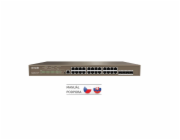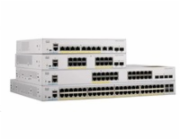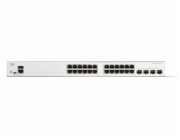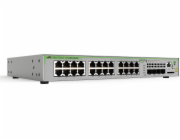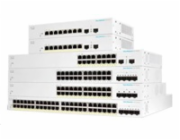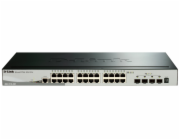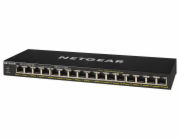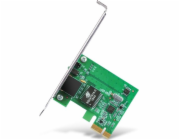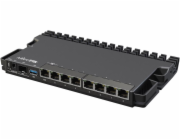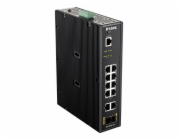KATEGORIE
Kategorie: Přepínače
17296 Kč
cena s DPH
Cisco Catalyst switch C1200-24FP-4G
Řada Cisco Catalyst 1200 je další generací cenově dostupných chytrých přepínačů, které kombinují vysoký výkon a spolehlivost s kompletní sadou funkcí, které potřebujete pro malé a středně velké podnikové sítě. Přepínače fungují na přizpůsobeném softwaru operačního systému Linux a poskytují flexibilní možnosti správy, komplexní možnosti zabezpečení a funkce statického směrování na 3. vrstvě, které daleko přesahují možnosti neřízeného nebo levného přepínače a to za nižší cenu než u plně spravovaných přepínačů. Když potřebujete spolehlivé řešení pro sdílení online zdrojů a připojení počítačů, telefonů a bezdrátových přístupových bodů, chytré přepínače Catalyst řady 1200 poskytují ideální řešení za dostupnou cenu.
Stránky produktu: C1200-24FP-4G
Performance Switching capacity and forwarding rate (All switches are wire-speed and nonblocking)
Capacity in millions of packets per second (mpps) (64-byte packets) 41,66
Switching capacity in gigabits per second (Gbps) 56
Layer 2 switching Spanning Tree Protocol (STP) Standard 802.1d spanning tree support
Fast convergence using 802.1w (Rapid Spanning Tree Protocol [RSTP]), enabled by default
Multiple spanning tree instances using 802.1s (MSTP); 8 instances are supported
Per-VLAN Spanning Tree Plus (PVST+); 126 instances are supported
Rapid PVST+ (RPVST+); 126 instances are supported
Port grouping/link aggregation Support for IEEE 802.3ad Link Aggregation Control Protocol (LACP)
Up to 4 groups
Up to 8 ports per group with 16 candidate ports for each (dynamic) 802.3ad Link Aggregation Group (LAG)
VLAN Support for up to 255 active VLANs simultaneously
Port-based and 802.1Q tag-based VLANs
Management VLAN
Guest VLAN
Auto Surveillance VLAN (ASV)
Voice VLAN Voice traffic is automatically assigned to a voice-specific VLAN and treated with appropriate levels of QoS. Voice Services Discovery Protocol (VSDP) delivers networkwide zero-touch deployment of voice endpoints and call control devices
Generic VLAN Registration Protocol (GVRP) and Generic Attribute Registration Protocol (GARP) Enable automatically propagation and configuration of VLANs in a bridged domain
Internet Group Management Protocol (IGMP) versions 1, 2, and 3 snooping Limits bandwidth-intensive multicast traffic to only the requesters; supports 255 multicast groups (source-specific multicasting is also supported)
IGMP querier Used to support a Layer 2 multicast domain of snooping switches in the absence of a multicast router
Head-of-Line (HOL) blocking HOL blocking prevention
Loopback detection Provides protection against loops by transmitting loop protocol packets out of ports on which loop protection has been enabled. It operates independently of STP
Layer 3 routing IPv4 routing Wire-speed routing of IPv4 packets
Up to 32 static routes and up to 16 IP interfaces
IPv6 routing Wire-speed routing of IPv6 packets
Layer 3 interface Configuration of Layer 3 interface on physical port, LAG, VLAN interface, or loopback interface
Classless Interdomain Routing (CIDR) Support for CIDR
Dynamic Host Configuration Protocol (DHCP) relay at Layer 3 Relay of DHCP traffic across IP domains
User Datagram Protocol (UDP) relay Relay of broadcast information across Layer 3 domains for application discovery or relaying of Bootstrap Protocol (BootP)/DHCP packets
Security Secure Sockets Layer (SSL) Encrypts all HTTPS traffic, allowing secure access to the browser-based management GUI in the switch
SSH Protocol SSH is a secure replacement for Telnet traffic. Secure Copy (SCP) also uses SSH. SSH v1 and v2 are supported.
IEEE 802.1X (authenticator role) RADIUS authentication, guest VLAN, single/multiple host mode, and single/multiple sessions
STP loopback guard Provides additional protection against Layer 2 forwarding loops (STP loops)
Secure Core Technology (SCT) Ensures that the switch will receive and process management and protocol traffic no matter how much traffic is received
Secure Sensitive Data (SSD) A mechanism to manage sensitive data (such as passwords, keys, and so on) securely on the switch, populating this data to other devices and a secure auto-configuration. Access to view the sensitive data as plain text or encrypted is provided according to the user-configured access level and the access method of the user
Trustworthy systems Trustworthy systems provide a highly secure foundation for Cisco products
Run-time defenses (Executable Space Protection [X-Space], Address Space Layout Randomization [ASLR], Built-In Object Size Checking [BOSC])
Port security Ability to lock source MAC addresses to ports and limit the number of learned MAC addresses
RADIUS Supports RADIUS authentication for management access. Switch functions as a client
Storm control Broadcast, multicast, and unknown unicast
DoS prevention DoS attack prevention
Multiple user privilege levels in CLI Level 1, 7, and 15 privilege levels
ACLs Support for up to 512 rules
Drop or rate limit based on source and destination MAC, VLAN ID, IPv4 or IPv6 address, IPv6 flow label, protocol, port, Differentiated Services Code Point (DSCP)/IP precedence, TCP/UDP source and destination ports, 802.1p priority, Ethernet type, Internet Control Message Protocol (ICMP) packets, IGMP packets, TCP flag; ACL can be applied on both ingress and egress sides
Time-based ACLs supported
Quality of service Priority levels 8 hardware queues
Scheduling Strict priority and Weighted Round-Robin (WRR) queue assignment based on DSCP and Class of Service (802.1p/CoS)
Class of service Port based, 802.1p VLAN priority based, IPv4/v6 IP precedence/Type of Service (ToS)/DSCP based, Differentiated Services (DiffServ), classification and re-marking ACLs, trusted QoS
Rate limiting Ingress policer, egress shaping and rate control per VLAN, per port, and flow based
Congestion avoidance A TCP congestion avoidance algorithm is required to reduce and prevent global TCP loss synchronization
Standards Standards IEEE 802.3 10BASE-T Ethernet, IEEE 802.3u 100BASE-TX Fast Ethernet, IEEE 802.3ab 1000BASE-T Gigabit Ethernet, IEEE 802.3ad Link Aggregation Control Protocol, IEEE 802.3z Gigabit Ethernet, IEEE 802.3x Flow Control, IEEE 802.3 ad LACP, IEEE 802.1D (STP), IEEE 802.1Q/p VLAN, IEEE 802.1w RSTP, IEEE 802.1s Multiple STP, IEEE 802.1X Port Access Authentication, IEEE 802.3af, IEEE 802.3at, RFC 768, RFC 783, RFC 791, RFC 792, RFC 793, RFC 813, RFC 879, RFC 896, RFC 826, RFC 854, RFC 855, RFC 856, RFC 858, RFC 894, RFC 919, RFC 920, RFC 922, RFC 950, RFC 951, RFC 1042, RFC 1071, RFC 1123, RFC 1141, RFC 1155, RFC 1157, RFC 1213, RFC 1215, RFC 1286, RFC 1350, RFC 1442, RFC 1451, RFC 1493, RFC 1533, RFC 1541, RFC 1542, RFC 1573, RFC 1624, RFC 1643, RFC 1700, RFC 1757, RFC 1867, RFC 1907, RFC 2011, RFC 2012, RFC 2013, RFC 2030, RFC 2131, RFC 2132, RFC 2233, RFC 2576, RFC 2616, RFC 2618, RFC 2665, RFC 2666, RFC 2674, RFC 2737, RFC 2819, RFC 2863, RFC 3164, RFC 3411, RFC 3412, RFC 3413, RFC 3414, RFC 3415, RFC 3416, RFC 4330
IPv6 IPv6 IPv6 host mode
IPv6 over Ethernet
Dual IPv6/IPv4 stack
IPv6 Neighbor Discovery (ND)
IPv6 stateless address auto-configuration
Path Maximum Transmission Unit (MTU) discovery
Duplicate Address Detection (DAD)
ICMP version 6
IPv6 over IPv4 network with Intrasite Automatic Tunnel Addressing Protocol (ISATAP) support
IPv6 QoS Prioritizes IPv6 packets in hardware
IPv6 ACL Drop or rate-limit IPv6 packets in hardware
Multicast Listener Discovery (MLD v1/2) snooping Delivers IPv6 multicast packets only to the required receivers
IPv6 applications Web/SSL, Telnet server/SSH, Ping, Traceroute, Simple Network Time Protocol (SNTP), Trivial File Transfer Protocol
2639 Kč
cena s DPH
8portový unmanaged ethernetový přepínač s možností flexibilního nastavení power budgetu PoE. 8x Gbit PoE/PoE+ port, PoE budget 60W. Led ukazatele informující o současné aktivitě každého portu. Možnost montáže do racku.
5670 Kč
cena s DPH
EdgeSwitch ES-8-150W
EdgeSwitch ES-8-150W je plně menežovací gigabitový switch s podporou aktivního PoE+ (802.3af/at), pasivního PoE 24V na všech portech. Vyznačuje se vysokým výkonen 10Gbps (non-blocking throughput), spolu s pokročilými L2/L3 funkcemi. K dispozici je inteligentní PoE - ve výchozím stavu je aktivní PoE dle 802.3af/at, v případně nutnosti pasivního PoE 24V lze manuálně nastavit. Switch je vybaven dvěma SFP sloty (1Gbps).
Každému portu lze nastavit jeho jméno, druh PoE, VLAN a operační mód (switching, mirroring, aggregate). K dispozici jsou statistiky přenesených dat, rychlostí, duplexu, stavu PoE, a VLAN nastavení.
(8) Gigabit RJ45 Ports
(2) SFP Ports
Non-Blocking Throughput: 10 Gbps
Switching Capacity: 20 Gbps
Forwarding Rate: 14.88 Mpps
Maximum Power Consumption: 150W
Supports POE+ IEEE 802.3at/af and 24V Passive PoE
Desktop-Mountable
Užitečné odkazy:
stránky výrobce UBNT.com
aktuální verze airOS
datasheety, uživatelské příručky
výpočet parametrů bezdrátového spoje - AirLink
návody pro začátečníky - BeansTalk
video-návody (ubnt youtube channel)
Ubiquiti Wiki
Ubiquiti oficiální fórum
7998 Kč
cena s DPH
Tenda TEG5328P-24-410W je 24 portový Gigabitový PoE switch s PoE af/at. 24x 10/100/1000 Mb/s PoE 802.3af/at (celkem 370 W) + 4x SFP 1000Mb/s + 1x Console. Layer L3 routing, STP/RSTP/MSTP, IGMP Snooping V1/V2/V3, VLAN, Static+aging ARP, SNMP, ochrana přepě
3649 Kč
cena s DPH
GbE porty 10/100/1000 Mbps
Jednoduchá správa přes webové rozhraní
Průvodce nastavením
Pokročilé funkce pro spolehlivou síť (detekce síťových smyček, podpora dvou image souborů, storm control, DoS a SSL)
Provedení bez ventilátoru
Podpora ekologického standardu Ethernet IEEE 802.3az a inteligentní ekologické funkce ZyXEL
Catalyst C1000-8FP-2G-L, 8x 10/100/1000 Ethernet PoE+ ports and 120W PoE budget, 2x 1G SFP and RJ-45
14635 Kč
cena s DPH
Catalyst 1000 8port GE, Full POE, 2x1G SFP
30222 Kč
cena s DPH
Provedení:Rack mounted 19"; Funkce:QoS (Quality of service), VLAN (virtual local area network), DHCP snooping, L2, L3, Web management/Smart switch; Technologie:Gigabit ethernet + 10 Gigabit optika; Počet portů LAN:24; Přenosová rychlost LAN (Mb/s):1000; P
372 Kč
cena s DPH
Programovací kabel USB/RJ45, 1,5m, konzolový kabel pro konfiguraci switchů, routrů, serverů přímo...
435 Kč
cena s DPH
MikroTik 24V2APOW; Náhradní zdroj od Mikrotiku pro Cloud Core Router řady CCR1009 a CRS317 . Celkový výkon zdroje je 60 W při napětí 24 V a maximálním proudu 2,5 A . Zdroj vyžaduje odbornou m...
11033 Kč
cena s DPH
Cisco switch CBS220-24P-4G
Řada Cisco Business 220 jsou jednoduché a cenově dostupné chytré switche pro sítě podnikové třídy. Díky podpoře mobilních aplikací, nástroji Cisco Business Dashboard a několika
možnostem PoE+ poskytuje CBS220 robustní síť v rámci omezeného rozpočtu.
Stránky produktu: CBS220-24P-4G
Quick start guide: Quick start guide
Switching capacity Forwarding rate in millions of packets per second (mpps; 64-byte packets) 41,66
Switching capacity in Gigabits per second (Gbps) 56
Layer 2 switching MAC table Up to 8,192 Media Access Control (MAC) addresses
Spanning Tree Protocol (STP) Standard 802.1d Spanning Tree support, enabled by default
Fast convergence using 802.1w (Rapid Spanning Tree [RSTP])
Multiple Spanning Tree instances using 802.1s (MSTP)
16 instances are supported
Port grouping Support for IEEE 802.3ad Link Aggregation Control Protocol (LACP)
Up to 8 groups
Up to 8 ports per group with 16 candidate ports for each (dynamic) 802.3ad link aggregation
Load balance based on source and destination MAC address, or source and destination MAC/IP
VLAN Support for up to 256 Virtual Local Area Networks (VLANs) simultaneously
Port-based and 802.1Q tag-based VLANs
Management VLAN
Guest VLAN
Auto voice VLAN Voice traffic is automatically assigned to a voice-specific VLAN and treated with appropriate levels of QoS
QinQ VLAN VLANs transparently cross a service provider network while isolating traffic among customers
Generic VLAN Registration Protocol (GVRP) and Generic Attribute Registration Protocol (GARP) Protocols for automatically propagating and configuring VLANs in a bridged domain
Head-of-Line (HOL) blocking HOL blocking prevention
Jumbo frame Frame sizes up to 9,216 supported
Loopback detection Loopback detection provides protection against loops by transmitting loop protocol packets out of ports on which loop protection has been enabled. It operates independently of STP.
Automatic Media-Dependent Interface Crossover (MDIX) Automatically adjusts transmit and receive pairs if an incorrect cable type (crossover or straight-through) is installed.
Security ACLs Drop or rate limit based on source and destination MAC, VLAN ID or IP address, protocol, port, Differentiated Services Code Point (DSCP)/IP precedence, Transmission Control Protocol (TCP)/ User Datagram Protocol (UDP) source and destination ports, 802.1p priority, Ethernet type, Internet Control Message Protocol (ICMP) packets, Internet Group Management Protocol (IGMP) packets, TCP flag
Support up to 512 rules
Port security Creates the ability to lock source MAC addresses to ports; limits the number of learned MAC addresses
IEEE 802.1X (authenticator role) 802.1X: Remote Authentication Dial-in User Service (RADIUS) authentication; guest VLAN;
Single-host, multiple-host, and multisession mode
RADIUS, TACACS+ Supports RADIUS and Terminal Access Controller Access Control System (TACACS) authentication; switch functions as a client
MAC address filtering Supported
Storm control Broadcast, multicast, and unknown unicast
DoS protection DOS attack prevention
STP Bridge Protocol Data Unit (BPDU) Guard This security mechanism protects the network from invalid configurations. A port enabled for BPDU Guard is shut down if a BPDU message is received on that port.
Spanning Tree Loop Guard This feature provides additional protection against Layer 2 forwarding loops (STP loops).
Secure Shell (SSH) Protocol SSH is a secure replacement for Telnet traffic. SCP also uses SSH. SSH v1 and v2 are supported.
Secure Sockets Layer (SSL) SSL support: Encrypts all HTTPS traffic, allowing highly secure access to the browser-based management GUI in the switch
QoS Priority levels 8 hardware queues per port
Scheduling Strict priority and Weighted Round-Robin (WRR) queue assignment based on DSCP and class of service (802.1p/CoS)
Class of service Port-based; 802.1p VLAN priority-based; IPv4/v6 IP precedence, Type of Service (ToS), and DSCP-based; Differentiated Services (DiffServ); classification and re-marking ACLs, trusted QoS
Rate limiting Ingress policer; egress shaping and rate control; per VLAN, per port, and flow-based
Congestion avoidance A TCP congestion avoidance algorithm is required to reduce and prevent global TCP loss synchronization.
Multicast Internet Group Management Protocol (IGMP) Versions 1, 2, and 3 Snooping IGMP limits bandwidth-intensive multicast traffic to only the requesters; supports 256 multicast groups
IGMP querier IGMP querier is used to support a Layer 2 multicast domain of snooping switches in the absence of a multicast router
Standards Standards IEEE 802.3 10BASE-T Ethernet, IEEE 802.3u 100BASE-TX Fast Ethernet, IEEE 802.3ab
1000BASE-T Gigabit Ethernet, IEEE 802.3ad LACP, IEEE 802.3z Gigabit Ethernet, IEEE
802.3x Flow Control, IEEE 802.1D (STP, GARP, and GVRP), IEEE 802.1Q/p VLAN, IEEE
802.1w RSTP, IEEE 802.1s Multiple STP, IEEE 802.1X Port Access Authentication, IEEE
802.3af, IEEE 802.3at, RFC 768, Request for Comments (RFC) 783, RFC 791, RFC 792, RFC 793, RFC 813, RFC 879, RFC 896, RFC 826, RFC 854, RFC 855, RFC 856, RFC 858, RFC 894, RFC 919, RFC 922, RFC 920, RFC 950, RFC 1042, RFC 1071, RFC 1123, RFC 1141, RFC 1155, RFC 1157, RFC
1350, RFC 1533, RFC 1541, RFC 1624, RFC 1700, RFC 1867, RFC 2030, RFC 2616, RFC
2131, RFC 2132, RFC 3164, RFC 3411, RFC 3412, RFC 3413, RFC 3414, RFC 3415, RFC
2576, RFC 4330, RFC 1213, RFC 1215, RFC 1286, RFC 1442, RFC 1451, RFC 1493, RFC
1573, RFC 1643, RFC 1757, RFC 1907, RFC 2011, RFC 2012, RFC 2013, RFC 2233, RFC
2618, RFC 2665, RFC 2666, RFC 2674, RFC 2737, RFC 2819, RFC 2863, RFC 1157, RFC
1493, RFC 1215, RFC 3416
IPv6 IPv6 IPv6 host mode
IPv6 over Ethernet
IPv6/IPv4 Dual Stack
IPv6 neighbor and router discovery (ND)
IPv6 stateless address auto-configuration
Path Maximum Transmission Unit (MTU) discovery
Duplicate Address Detection (DAD)
ICMP version 6
IPv6 ACL Drop or rate limit IPv6 packets in hardware
IPv6 QoS Prioritize IPv6 packets in hardware
Multicast Listener Discovery (MLD v1/2) Snooping Deliver IPv6 multicast packets only to the required receivers
IPv6 applications Web/SSL, Telnet server/SSH, DHCP Client, DHCP Autoconfig, Cisco Discovery Protocol (CDP), Link Layer Discovery Protocol (LLDP)
IPv6 Requests for Comments (RFCs) supported RFC 4443 (which obsoletes RFC2463) - ICMP version 6
RFC 4291 (which obsoletes RFC 3513) - IPv6 address architecture
RFC 4291 - IPv6 addressing architecture
RFC 2460 - IPv6 specification
RFC 4861 (which obsoletes RFC 2461) - Neighbor discovery for IPv6
RFC 4862 (which obsoletes RFC 2462) - IPv6 stateless address auto-configuration
RFC 1981 - Path MTU discovery
RFC 4007 - IPv6 scoped address architecture
RFC 3484 - Default address selection mechanism
Management Cisco Business Dashboard Support direct management with Cisco Business Dashboard and mobile app. Eliminates the need to set up a separate hardware or virtual machine for the Cisco Business Dashboard Probe on site.
Cisco Business mobile app Mobile app for Cisco Business Switch and Wireless products. Helps to set up a local network in minutes and provide easy management at your fingertips.
Cisco Network Plug and Play (PnP) agent The Cisco Network Plug and Play solution provides a simple, secure, unified, and integrated offering to ease new branch or campus device rollouts or for provisioning updates to an existing network. The solution provides a unified approach to provision Cisco routers, switches, and wireless devices with a zero touch deployment experience.
Supports Cisco PnP Connect
Web user interface Built-in switch configuration utility for easy browser-base
11542 Kč
cena s DPH
28-portový gigabitový stohovateľný inteligentný riadený prepínač vrátane 4 portov 10G SFP+ - 24 x 10/100/1000Mb/s porty s automatickým vyjednávaním - 4 x porty 10G SFP+ - fyzické stohovanie až 6 jednotiek na stoh. Šírka pásma fyzického stohovania 40Gb. Topológia Lineárna alebo kruhová. - Kapacita prepínača 128 Gb/s - D-Link Green 3.0, 802.3az - Virtuálne stohovanie až 32 zariadení. - Statická trasa - IPv6 Management/Ready Logo - Half-/Full-Duplex, auto-negotiation, Auto MDI/MDIX - IEEE 802.3x Flow Control - 802.3ad Link Aggregation - Asymetrická VLAN, Auto Voice VLAN, GVRP - 802.1p prioritné fronty - filtrovanie MAC/IP - MAC/IP ACL - 802.1X riadenie prístupu na báze portov, zabezpečenie portov, segmentácia prevádzky - D-Link Safequard Engine - D-Link Network Assist, webová správa, kompaktné CLI - Dual Image FW - 19" stojanová inštalácia.
6005 Kč
cena s DPH
NETGEAR 16-Port GB PoE+ unmanaged Switch 183W FlexPoE
5280 Kč
cena s DPH
Směrovač s pasivním chlazením, RouterOS v7 L5, 7 GbE RJ-45 konektorů, 2.5GbE RJ-45 port a 10GbE SFP+ slot, vzdálená správa přes GUI Winbox či mobilní aplikaci MikroTik Pro, 3 možnosti napájení – PoE-in (802.3af/at), DC Jack a 2-pinová svorka. Kov. Černá.









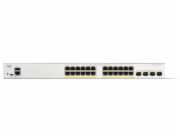

![UBNT EdgeSwitch ES-8-150W [8xGigabit, 150W PoE+ 802.3at/af, pasivní PoE 24V, 2xSFP slot, non-blocking 10Gbps] UBNT EdgeSwitch ES-8-150W [8xGigabit, 150W PoE+ 802.3at/af, pasivní PoE 24V, 2xSFP slot, non-blocking 10Gbps]](/imgThumbnailM/2001097.png)
